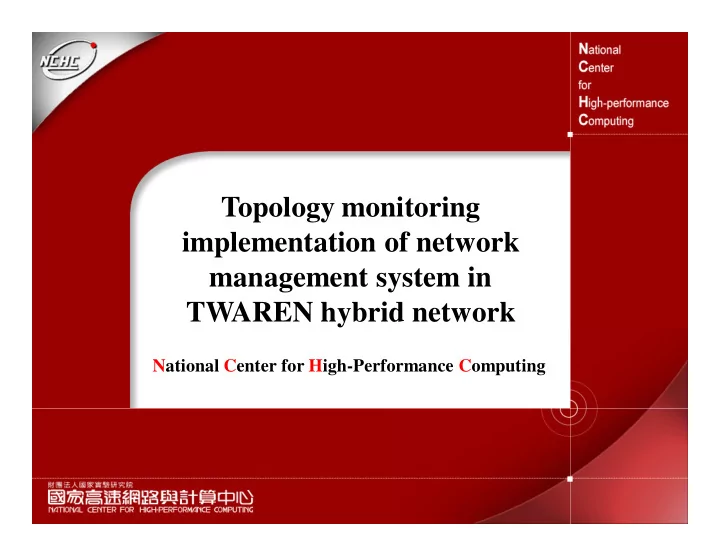

Topology monitoring implementation of network management system in TWAREN hybrid network National Center for High-Performance Computing 1
ABSTRACT � TWAREN (TaiWan Advanced Research and Education Network) is a hybrid network composed of several types of network services including Layer1 (Light-path), Layer2 (VLAN, MPLS-VPN and VPLS-VPN), Layer3 (research networks peering and transit) and Layer7 (SSL VPN). To develop a network management system for such kind of hybrid networks, we must firstly be able to construct the physical network topology, therefore the logical network services can then be mapped and an accurate monitoring and alarming system can be possible. However the automatic physical topology discovery is extremely hard and complicated in the hybrid network. In this paper, we propose our preliminary design on automatically detecting the hybrid network physical topology in TWAREN. 2
The architecture of TWAREN Backbone . 3
The light-path topology of TWAREN Backbone 4
Issues � Any circuit or interface failure will affect a large number of logical network paths running on top of it, thus causing even more scattered alarms, making the problem identification even harder. � It is difficult to automatically discover the topology on a hybrid network. 5
Collect information � We use the following techniques to construct the topology of network equipments and interfaces in TWAREN: � The network equipment configuration � SNMP � TL1 (Transaction Language 1) 6
DESIGN AND IMPLEMENTATION 7
Interface naming rules � The interface of the ethernet equipment ends will be named like as follow line � “TN7609P_1-1-2_TN15454_1-100-2_For- Research-Net” � which means the GE-1/1/2 of the TN7609P connects to the CE1000-1/2 of the TN15454. � The interface of the optical equipment end is named like as follow line � “__TN7609P_1-1-2_ForResearch” � which means its opposite end connects to the GE-1/1/2 of TN7609P. 8
9
10 10
11 11
Relationships of ONSs � The relationship between two optical equipments can be obtained directly by ONS TL1 commands. We use one TL1 command to discover all adjacent ONS, another TL1 command to show all the internal cross connections (e.g. vcM-vcN of Port A connects to vcP-vcQ of port B) and a final TL1 command to show all the outgoing cross connections (e.g. vcS-vcT of port C connects to the vcU-vcV of port D of another ONS). After all the optical circuit information is retrieved, a full optical lightpath map can be constructed. 12 12
13 13
Determining the relationship between ethernet equipments � Since the CDP protocol can be used to discover this relationship, only a simple MIB information retrieval can provide us the necessary information. After integrating the information together, the topology of ethernet equipments can be realized. Since we already have the optical-ethernet and the optical-optical topology, the topology from both technologies can be safely integrated without duplication. 14 14
The last step � The last step is to deal with those equipments which don't support Cisco CDP or don't have interoperable CDP implementations. Since there is no way to discover the topology relationship between this kind of equipments, the aforementioned naming scheme is again used. � After all physical interconnections have been identified; the upper layer logical network services can be easily mapped to the physical map to form a complete functional topology map. 15 15
THANKS FOR YOUR ATTENTION 16 16
Recommend
More recommend